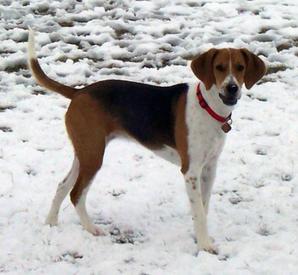
Often mistaken for the Beagle or the Foxhound, the Harrier is a relatively rare breed thought to have descended from the English Fox Terrier, English Foxhound and the Greyhound. Part of the 'hound' breed group, the Harrier was primarily bred to hunt fox and hare and existed in Colonial America; whilst the breed is now relatively rare in the United States, it is still favoured in England, thought to have arrived with the Norman invasion of 1066. Commonly utilised as a pack hunter, the Harrier is prized for its stamina and willingness, dogged in its efforts to track but at a far slower pace than other hounds, allowing the hunters to successfully trail on foot.
Smaller than the English Foxhound, the Harrier is proportioned and athletic-looking, possessing a deep chest for enhanced lung capacity and stamina, a broad forehead, square-cut muzzle and low-set, triangular ears. The coat is generally short, smooth and tri-coloured, or else commonly coloured lemon and white, white and tan or red and white. An inherent pack leader, the Harrier is both able-bodied and independent-minded, so firm leadership, consistent training and early socialisation is essential from an early age. Energetic and agile, the Harrier should be kept on a lead in public areas and in a high-fenced garden to prevent escape.
Likened to the Beagle in activity and temperament, the Harrier is alert, intelligent and vigilant, making for a great watch dog. Its inherent instincts to hunt, chase and retrieve need management from puppyhood in order to adapt it to relaxed domestic living, especially where other house pets are involved. On average, a healthy Harrier will weigh 18-27 kg depending on its gender, with a life expectancy of 10-12 years when shown the appropriate love and care.
A typically healthy breed, the Harrier rarely suffers with optical complaints. The most common problem identified is hip dysplasia, a condition that is observed in most breeds.
Do you own a Harrier? Let others know what they're like!
Related products
Advantage 80 Spot On Flea Control Large Cats and Rabbits
from £10.89
Advantage 40 Spot On Flea Control Cats, Small Dogs and Rabbits
from £10.89
Advantage 100 Spot On Flea Control Medium Dog
from £10.89
Drontal Tasty Bone Wormer Tablets for Small & Medium Dogs (2 to 20kg)
from £1.69
Advantage 250 Spot On Flea Control Large Dog
from £10.89
FRONTLINE Plus Flea & Tick Treatment Dogs & Cats
from £16.29
TermaWorm™ Tablets for Cats & Dogs
from £1.59
Drontal Tasty Bone XL Wormer Tablets for Large Dogs (Over 20kg)
from £5.09